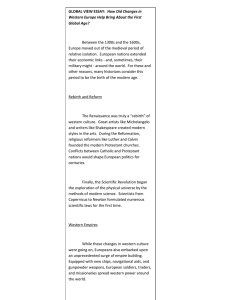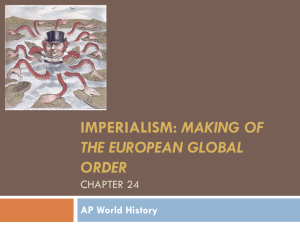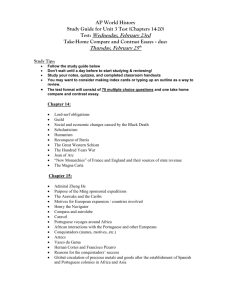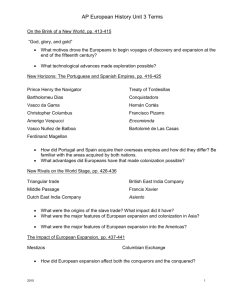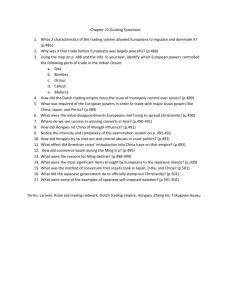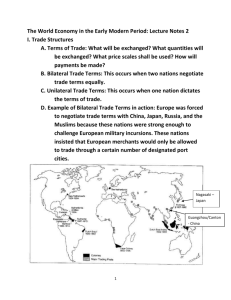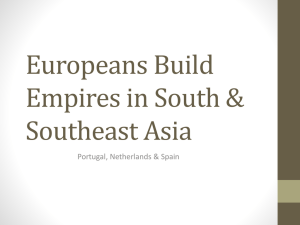Conrad Demarest Model of Empire
advertisement
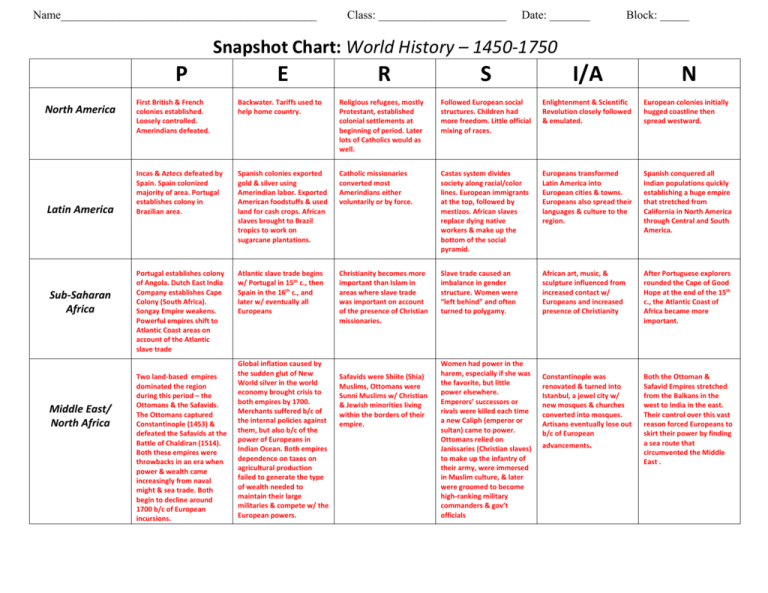
Name____________________________________________ Class: ______________________ Date: _______ Block: _____ Snapshot Chart: World History – 1450-1750 P North America Latin America Sub-Saharan Africa Middle East/ North Africa E R S I/A N First British & French colonies established. Loosely controlled. Amerindians defeated. Backwater. Tariffs used to help home country. Religious refugees, mostly Protestant, established colonial settlements at beginning of period. Later lots of Catholics would as well. Followed European social structures. Children had more freedom. Little official mixing of races. Enlightenment & Scientific Revolution closely followed & emulated. European colonies initially hugged coastline then spread westward. Incas & Aztecs defeated by Spain. Spain colonized majority of area. Portugal establishes colony in Brazilian area. Spanish colonies exported gold & silver using Amerindian labor. Exported American foodstuffs & used land for cash crops. African slaves brought to Brazil tropics to work on sugarcane plantations. Catholic missionaries converted most Amerindians either voluntarily or by force. Castas system divides society along racial/color lines. European immigrants at the top, followed by mestizos. African slaves replace dying native workers & make up the bottom of the social pyramid. Europeans transformed Latin America into European cities & towns. Europeans also spread their languages & culture to the region. Spanish conquered all Indian populations quickly establishing a huge empire that stretched from California in North America through Central and South America. Portugal establishes colony of Angola. Dutch East India Company establishes Cape Colony (South Africa). Songay Empire weakens. Powerful empires shift to Atlantic Coast areas on account of the Atlantic slave trade Atlantic slave trade begins w/ Portugal in 15th c., then Spain in the 16th c., and later w/ eventually all Europeans Christianity becomes more important than Islam in areas where slave trade was important on account of the presence of Christian missionaries. Slave trade caused an imbalance in gender structure. Women were “left behind” and often turned to polygamy. African art, music, & sculpture influenced from increased contact w/ Europeans and increased presence of Christianity After Portuguese explorers rounded the Cape of Good Hope at the end of the 15th c., the Atlantic Coast of Africa became more important. Constantinople was renovated & turned into Istanbul, a jewel city w/ new mosques & churches converted into mosques. Artisans eventually lose out b/c of European Both the Ottoman & Safavid Empires stretched from the Balkans in the west to India in the east. Their control over this vast reason forced Europeans to skirt their power by finding a sea route that circumvented the Middle East . Two land-based empires dominated the region during this period – the Ottomans & the Safavids. The Ottomans captured Constantinople (1453) & defeated the Safavids at the Battle of Chaldiran (1514). Both these empires were throwbacks in an era when power & wealth came increasingly from naval might & sea trade. Both begin to decline around 1700 b/c of European incursions. Global inflation caused by the sudden glut of New World silver in the world economy brought crisis to both empires by 1700. Merchants suffered b/c of the internal policies against them, but also b/c of the power of Europeans in Indian Ocean. Both empires dependence on taxes on agricultural production failed to generate the type of wealth needed to maintain their large militaries & compete w/ the European powers. Safavids were Shiite (Shia) Muslims, Ottomans were Sunni Muslims w/ Christian & Jewish minorities living within the borders of their empire. Women had power in the harem, especially if she was the favorite, but little power elsewhere. Emperors’ successors or rivals were killed each time a new Caliph (emperor or sultan) came to power. Ottomans relied on Janissaries (Christian slaves) to make up the infantry of their army, were immersed in Muslim culture, & later were groomed to become high-ranking military commanders & gov’t officials advancements. Europe Russia/ Central Asia East Asia Moving away from the decentralized feudal system of the medieval period, Europeans began to establish a fragmented system of independent, competitive national states. The Italian city-states were powerful at first & then lost ground to the British & the Dutch. The Portuguese & Spanish built large overseas empires in the 16th c. followed by the British, Dutch, & French in the 17th c. Many European monarchs began centralizing their power to create absolutist regimes. Chartered trading companies (esp. Dutch & British) represent early form of capitalism. European gov’ts adopted policies of mercantilism that encouraged exports & managed trade b/t colonies & mother countries. African slaves became increasingly important especially in the plantation labor of European colonies in the Americas. The Columbian Exchange led to an agricultural revolution that increased availability of food in Europe Protestant Reformation led an end of dominance by the Catholic Church & the Pope. Led to religious wars & to the Inquisition. Push to find converts in new parts of the world to maintain Catholic power leads to the globalization of Christianity. Kings & aristocrats continue to have power. Europe continues pattern of nuclear families giving women relatively more rights. Old patterns of authority begin to be questioned with the Renaissance, Scientific Revolution, & Enlightenment The humanist world-view of the Renaissance changes art completely as it moves away from church art to more secular & classical subjects. Protestant Reformation begins emphasis on vernacular languages. Printing press makes literacy more accessible. Enlightenment & Scientific Revolution spark new technologies and ideas about the role of religion & gov’t. Portugal establishes a maritime empire in the Indian Ocean region and will later be replaced by the Dutch & British. Spain established huge colonial empire in the Americas followed by France and Britain. Little Ice Age affects crops. Many European poor migrate to the Americas. Ivan III establishes Russia after Mongols leave. Creates absolute monarchy continued by Romanovs. Serfdom was the economic system. Did not promote innovation. Russia exported grain to Europe & serfs grew potatoes at home. Problem: Russia really did not have market economy. Cesaropapism: Czar is head of state & church. Influenced by Byzantine Orthodoxy. Becomes Russian Orthodox Church Upper class forced to perform for state Under Peter the Great’s reign, nobles could not marry w/o permission from the state, they were forced to change haircut & shave beard & live part-time in St. Petersburg. Most of the population was serfs. Westernization & improvement of technology under Peter the Great. Technological advances limited b/c of peasant labor. Russia lags behind other European nations. Architecture in St. Petersburg very western. Expands empire eastward into Siberia & Alaska. Pelts the main driver as is arable land. Needed warm water port thus looked to the west to gain territory along Baltic Sea. Began to expand southward into Ottoman territory. In China, the Ming Empire gave way to the Manchuruled Qing Empire which expanded China’s borders while continuing careful regulation of outside trade & other influences. Tokugawa Shogunate centralized authority in Japan. Japan keeps closer eye on the west. Both China & Japan are isolated. Few foreign traders allowed after “corruptive influence of the west”. Agriculture expands. China & Japan are core-periphery trading partners. Ming gov’t’s requirement that all taxes & trade fees be paid in silver established the “silver drain” that eventually hurts Chinese economy. Tokugawa Japan becomes one of world’s largest producers of silver after enormous silver deposits are found in mid-16th c. Christians (esp. Jesuit Catholics) initially welcomed in both China & Japan as counterbalance to Buddhism, and then seen as corrupting & dangerous. Christianity outlawed. Both in China & Japan, women were of low status. Merchants were seen as second class citizens. Japan had a feudal society with the samurai class high ranking. China continued to venerate its scholar gentry class. Return to nativism seen as important in both China & Japan. Japan introduces national learning while China re-institutes exam system. Very isolated. China returned to traditional dynastic patterns while the Qing expanded to include all of China, the island of Taiwan, and even parts of Mongolia & Central Asia. Japan consolidated under the shogunates becoming one “country” South Asia Southeast Asia Mughal Empire established in 1523. Akbar was very effective, but followed by ineffective leadership. European (esp. Portuguese, Dutch, British, & French) attempt to control states in the region via the choke points. Not easily done, but European influence is considerable. Non-Muslim tax abolished. High demand for Indian cotton cloth, especially Batik cloth made for specific rulers in Africa in exchange for slaves. Spices exported to Europe & Asia. Long trading relationships w/ China, India, & Muslims gave way to European control. Akbar rules non-Muslims such as Hindus and tries to reconcile the faiths. Sikhism results from interaction of cultures. Hindus seen as people of the book b/c they are so numerous. Intermarriage b/t Muslims & Hindus encouraged. Abolishment of widow suicide (suttee). Women still seen as having very little power. Mughal rulers patronized the arts. Create a syncretism in architecture that combines Indian & Persian motifs (ex. Tajo Jamal). Also similar melding in literature & painting. Europeans brought Christian missionaries. Natives were already Buddhists, or Hindus, or Muslims reflecting the eclectic trading relationships. Women were often merchants in this area of the world b/c it was seen as menial job. Some European men married the Native women to gain access to trade. Art & intellectual pursuits often mirrored the civilization that the SE Asians traded with. Much maritime technology originated from this region. Very similar to Period 3 Chart Oceania Although attempts to unify the continent work for a while, southern provinces separate & return to pattern of independent principalities. Vast regions in the Eastern Indian ocean & western Pacific. Winds & currents tended to direct ships into narrow channels.
